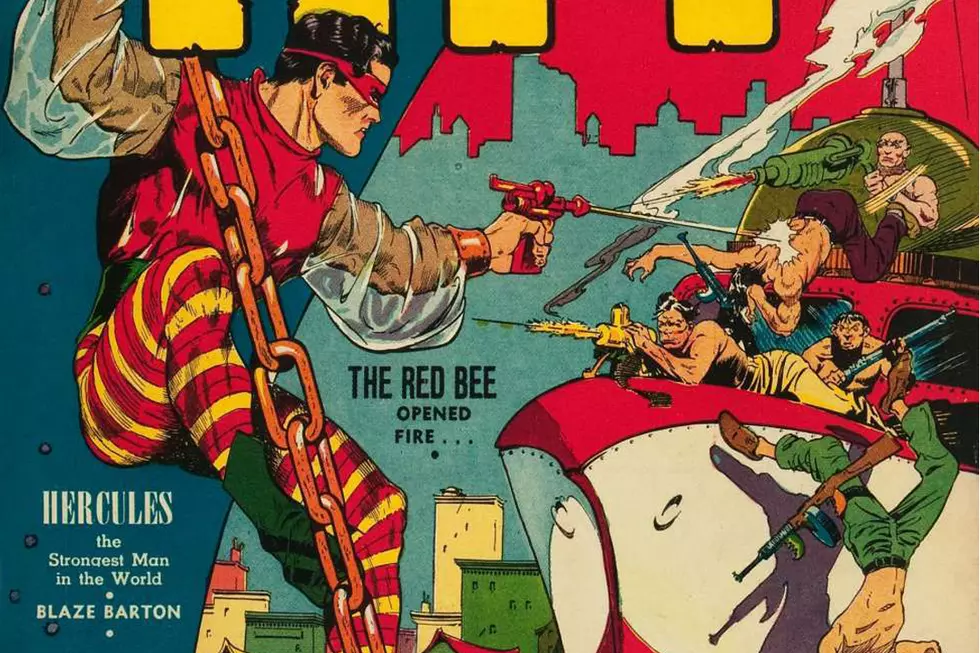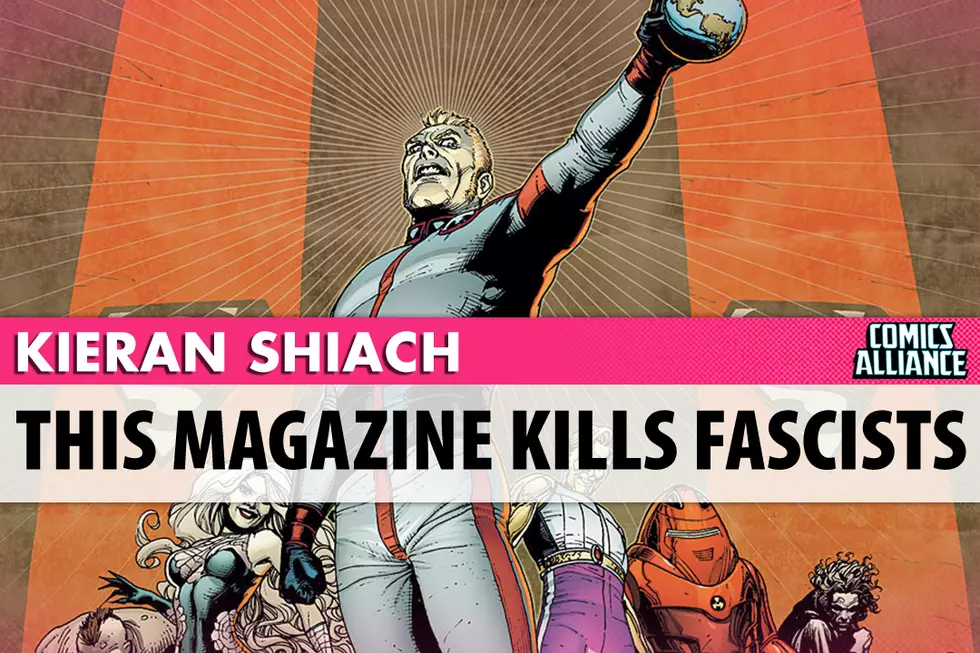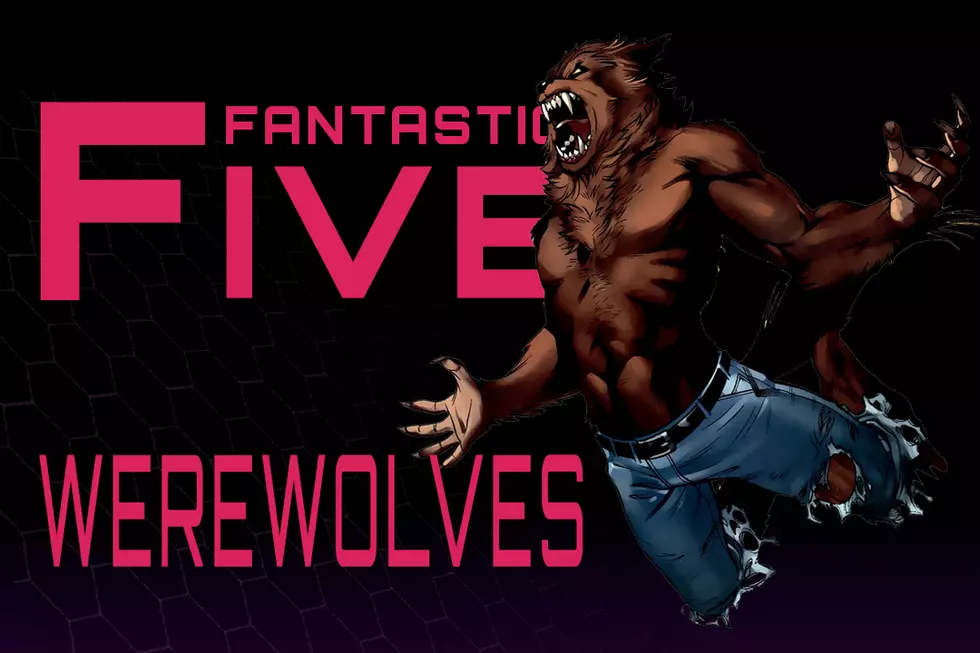
Ask Chris #122: The Legion of Super-Heroes
Over a lifetime of reading comics, Senior Writer Chris Sims has developed an inexhaustible arsenal of facts and opinions. That's why each and every week, we turn to you, to put his comics culture knowledge to the test as he responds to your reader questions!

Q: Please tell us which version of the Legion of Super-Heroes is best and why the Legion is awesome. -- @adampknave
A: What's the best Legion? Easy: the one that showed up on Smallville, of course. Next question.I kid, I kid. But the question of one's favorite version of the Legion of Super-Heroes is a deceptively complex one. It's not just a matter of team line-ups or creative teams, but the actual directions and themes explored by the franchise. The Legion has been relaunched and repackaged more than anything else in the DC Universe -- a universe where the line-wide reboot has become the go-to move -- and each time it's based on different ideas of what these characters mean, and what the future looks like. As much as they might be in the same continuity, the original Legion has a completely different set of ideals that it's exploring than the Dystopian "Five Years Later" Legion of the '80s, and when Mark Waid and Barry Kitson "threebooted" the Legion in 2004, their stories were a reaction to a completely different environment in comics than when they rebooted it the first time ten years earlier.
And because each version of the Legion is so thematically different than the others, the question of which one's your favorite has a lot to do with which of those themes you find appealing. For me, there's no question, and I'm sure this won't surprise anyone: I love the original Silver Age Legion.
Part of that comes from the same reason that I love a lot of Silver Age books, in that it's just full of bizarre kookiness, with a sci-fi setting that allowed the creators to ratchet the weirdness up even higher than they did in the regular line back in those days. There's one story in the '60s where someone's spying on the Legion and they can't figure out who until they realize that there's a tiny little man living in Sun Boy's ankle who was surgically implanted there by one of their enemies when Sun Boy went to the dentist, and it's hard to say if that was actually the craziest thing they ever did in those stories.

But more than that, there's an optimism to it.
When I talked to him about writing the Star Trek / Legion crossover, Chris Roberson told me that one of the things that attracted him to both franchises was that they both showed an optimistic future, and he's right. When you think about the time when the Legion was created in 1958 and those years in the '60s when they grew in popularity, that was the same time when people were building fallout shelters in the back yard and teaching school kids to duck and cover under a school desk in the event of an atom bomb. Nuclear war wasn't just a possibility, it was seen as something that was pretty much inevitable, and that was reflected in the fiction of the time. This was the dawn of the post-apocalyptic story, with increasingly grim visions of the future based on the destruction that we'd already seen.
But with Silver Age comics in general, and the Legion in particular, it was different. I imagine that the Comics Code and a desire to not get any irate letters from parents about terrifying their children with visions of nuclear holocaust were as much a motivating factor as any bright-eyed hope for the future when creators like Otto Binder and Jerry Siegel approached it, but the fact remains that they showed us a future that was thriving.
The Legion's 30th Century wasn't quite a utopia, but it wasn't a wasteland either. It was a glimpse of a future where everything worked out okay, with a galaxy of strange aliens from even stranger worlds united behind Earth. Well, okay, admittedly, they were less strange aliens and more "a bunch of white people and one green dude," but the sentiment was there. The very existence of that art deco skyline of the 30th century was a sign that we as a civilization had made it through, even when it was under attack by computer robots.

There's actually a story from 1964 -- the first appearance of Dream Girl, if you want to look it up -- where a few Legionnaires take a one-panel field trip to a world that actually has been destroyed in an atomic war, but for them, it's a strange historical curiosity that they're viewing from the outside. It's a "might have been" and not a "definitely will."
Of course, the fact that things worked out okay was to be expected. Even though we were in danger here in the real world, the Legion's future was descended from an Earth that had Superman protecting it, which points to another great element of the team. They have that same aspirational element to them that I love about characters like Robin and Jimmy Olsen, but it's applied to an entire universe. The existence of the Legion is predicated on two different ideas about Superman. The first is just that Superman is there to make sure that their future exists, and as simple as that might sound, the fact that we see the end result of what he does makes his struggle in that Never-Ending Battle against evil mean something. A dystopian future means that he failed somewhere along the line and that in the end, all of his good works didn't matter. A future that's bright and united, however, means that all of those times he saved the world from Luthor or Brainaic actually counted for something, that there was something out there to make it worthwhile.
And the second is that it's those battles, and Superman specifically, that inspire the Legion to form and use their powers to do the same thing he did. It's a pretty strong recommendation for his character that his legend and his accomplishments last for the next thousand years, and it lends a power to the mythology of Superman. It immediately puts him in the ranks of Hercules and Robin Hood, these figures that we still talk about a thousand years (or more) after they first entered culture. It just does it in a way that we don't have to wait around to see if it actually works out that way once 2958 rolls around.
Just as important as that, though, it casts the Legionnaires themselves as fans. Just like Jimmy Olsen, it brings the idea that the readers themselves could be part of the story to the forefront, with the added wish fulfillment of granting them super-powers and sending them off on their own adventures. It's something that Waid and Kitson touched on in their "Threeboot" Legion, going as far as to have the characters actually sitting around reading Silver Age comics and drawing inspiration from the adventures there to escape from the boring repetition of their world. Which, incidentally, may be a metaphor for what was going on in the rest of the DC Universe at the time. Who knows.
Anyway, that ties in with yet another element that I find really appealing, that springs right from the fact that they're so readily identifiable to the readers: The Legion are a bunch of kids. There are later versions where the same characters have grown up, but for me, that doesn't work as well at all. It breaks one of the best metaphors of the entire franchise, that they're children, a group that symbolizes the future, who also literally represent the future. They're the ones looking around at their world with fresh eyes and going "Hey, we should all just be like Superman." Adults -- with the exception of those who sit around thinking about funnybooks all day -- don't think like that, but kids do, and the Legion are a bunch of kids who actually have the power to make that work.
Incidentally, I feel the same way about the X-Men -- not that there should never be grown-up X-Men, but that there should always be some kind of emphasis on young characters and the school. The metaphor of evolution and the newer, younger species arriving to possibly replace the old is just too good to pass up.
Speaking of the X-Men, I think it's fair to say that that's a franchise that owes a lot to the Legion, and not just because Dave Cockrum originally designed Nightcrawler and Colossus as Legionnaires before they were rejected and sent packing across town to Marvel. Because it was set in the future and not bound to the rest of the DC Universe, the Legion was free to build its own continuity, and it took a path of change and dynamism that you didn't usually see in the Silver Age. Things didn't always end with a return to the Status Quo. Lightning Lad died, came back, lost an arm, and had it replaced. New members joined. Prospective members were rejected and formed their own teams. A third of Triplicate Girl was killed off "permanently" and she returned as Duo Damsel. Things changed.
But the most important thing that the X-Men and most other comics about teenage superheroes lifted from the Legion is that for the first time, kids with super-powers acted like actual kids. And by that, I mean that they were massive jerks to each other.

And I love that about them.
I wrote about this once for a book of essays on the Legion called Teenagers From The Future (available now in finer bookstores everywhere, tell your friends), but it really just boils down to this: When adults are jerks to each other, they're just jerks, but when kids are jerks it's because they're kids. Kids make up weird rules about things and get unreasonably angry when someone breaks them. They form clubs with bizarre secret rules that they take too seriously until they forget about them and never bring them up again. They're dicks to each other for no discernible reason.
And that is exactly how the Legion conducts itself.
Maybe the best example of this is the occasional recruitment drives, which are literally just stories where characters like Matter Eater Lad and Light Lass (she makes things less heavy!) sit around and tell other super-powered youths how much they suck:

I spent a good chunk of my youth attending public school, so I can go ahead and confirm that this is exactly what it would be like if teenagers actually had super-powers. He can avert nuclear war, but even Superman can't make kids stop being jerks to each other.
And they were jerks. Their very first appearance is based around going back in time to play a prank on this guy that they idolize, and it just builds from there. At least one out of every three stories is some variation on that theme, and they get weird with it. The first time Supergirl meets the Legion, they don't let her join because exposure to Red Kryptonite has made her "over 18" for like an hour. Keep in mind: this is a temporary condition and they are time travelers. And occasionally, they just turn on each other, living out a kid's idea of gender relationships:

There's a lot of Legion runs that I love, but that original has never been topped for how much it appeals to me, which might seem a little weird when you consider that I got into it around 2006 at the age of 24 after never reading a Legion story in my life and not when I was the age where I actually should've been identifying with these characters. But there's something there that I can't deny the appeal of, that combination of hopeful optimism and kids being jerks, of Silver Age weirdness and emotional authenticity, and the past's idea of what the future could be if we all made it through.
That's all we have for this week, but if you've got a question you'd like to see Chris tackle in a future column, just send it to @theisb on Twitter with the hashtag #AskChris, or send an email to chris@comicsalliance.com with [Ask Chris] in the subject line!
More From ComicsAlliance









